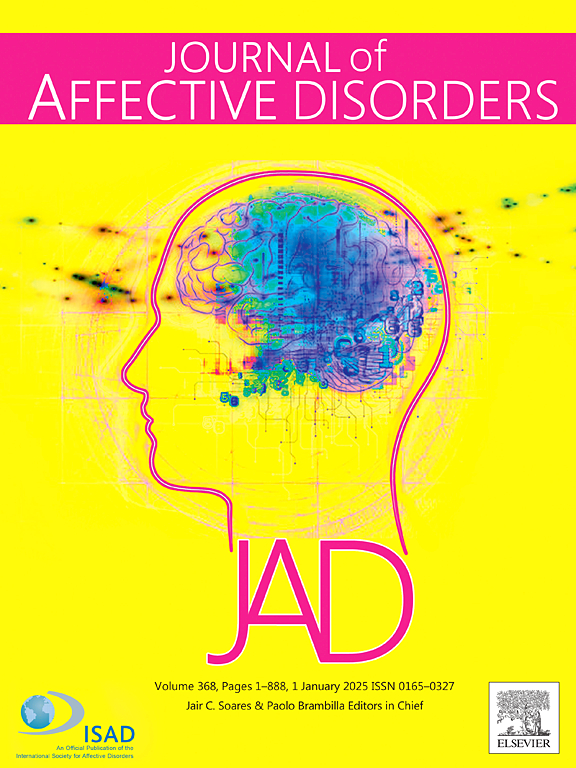Resilience and childhood trauma in mood disorders: Psychopathological implications and treatment response
IF 4.9
2区 医学
Q1 CLINICAL NEUROLOGY
引用次数: 0
Abstract
Background and aim
Childhood trauma is a key risk factor for mood disorders and is associated with greater clinical severity, while resilience may act as a protective factor. This study investigates how childhood trauma and resilience interact to shape psychopathology and treatment response in patients with major depressive disorder (MDD) and bipolar disorder (BD).
Methods
The study included 669 participants: 569 patients (380 MDD, 189 BD) and 100 healthy controls (HC). Symptom severity was assessed using standardized scales, with follow-up evaluations of depressive symptoms at six months. All participants completed the Childhood Trauma Questionnaire (CTQ) and Connor-Davidson Resilience Scale (CD-RISC).
Results
Patients showed lower resilience and higher childhood trauma scores than HC (both p < 0.001), with more marked differences in those with depressive or anxiety symptoms (p < 0.05). In MDD, low resilience was linked to anhedonia, psychomotor retardation, general psychopathology, suicidality, and non-remission (all p ≤ 0.001), while in BD, it was associated with depressive and anxiety severity and anhedonia (all p ≤ 0.01). Childhood trauma was unrelated to most outcomes, except for higher scores in suicidal MDD patients (p = 0.010), and showed an inverse correlation with resilience in MDD and HC. Linear regression showed that gender (p = 0.013) and anhedonia (p = 0.005) significantly predicted resilience. Logistic regression revealed that higher resilience predicted remission (p = 0.012).
Conclusions
Resilience and childhood trauma influence clinical severity in mood disorders. Resilience emerged as a protective factor and predictor of remission, supporting its role as a therapeutic target.
情绪障碍的恢复力和童年创伤:精神病理意义和治疗反应
背景和目的童年创伤是情绪障碍的关键危险因素,与更严重的临床严重程度相关,而恢复能力可能是一种保护因素。本研究探讨了童年创伤和恢复力如何相互作用,影响重度抑郁症(MDD)和双相情感障碍(BD)患者的精神病理和治疗反应。方法纳入669例受试者:569例患者(重度抑郁症380例,双相障碍189例)和100例健康对照(HC)。使用标准化量表评估症状严重程度,并在6个月时对抑郁症状进行随访评估。所有参与者均完成了童年创伤问卷(CTQ)和康诺-戴维森弹性量表(CD-RISC)。结果患者心理韧性较低,儿童创伤评分较高(p <;0.001),有抑郁或焦虑症状的患者差异更显著(p <;0.05)。在MDD中,低弹性与快感缺乏、精神运动迟缓、一般精神病理、自杀倾向和非缓解相关(均p≤0.001),而在BD中,低弹性与抑郁、焦虑严重程度和快感缺乏相关(均p≤0.01)。童年创伤与大多数结果无关,除了自杀性MDD患者得分较高(p = 0.010),并且与MDD和HC的恢复力呈负相关。线性回归显示,性别(p = 0.013)和快感缺乏(p = 0.005)显著预测心理弹性。Logistic回归显示,较高的心理弹性预示着缓解(p = 0.012)。结论心理弹性和童年创伤影响心境障碍患者的临床严重程度。恢复力作为一种保护因素和缓解的预测因子出现,支持其作为治疗靶点的作用。
本文章由计算机程序翻译,如有差异,请以英文原文为准。
求助全文
约1分钟内获得全文
求助全文
来源期刊

Journal of affective disorders
医学-精神病学
CiteScore
10.90
自引率
6.10%
发文量
1319
审稿时长
9.3 weeks
期刊介绍:
The Journal of Affective Disorders publishes papers concerned with affective disorders in the widest sense: depression, mania, mood spectrum, emotions and personality, anxiety and stress. It is interdisciplinary and aims to bring together different approaches for a diverse readership. Top quality papers will be accepted dealing with any aspect of affective disorders, including neuroimaging, cognitive neurosciences, genetics, molecular biology, experimental and clinical neurosciences, pharmacology, neuroimmunoendocrinology, intervention and treatment trials.
 求助内容:
求助内容: 应助结果提醒方式:
应助结果提醒方式:


